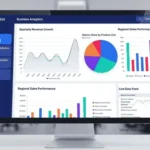A business owner once asked me:
“I searched for my brand name on Google, and I saw competitors showing up in those big info boxes with all the details. Why doesn’t my business appear there?”
What he saw was a knowledge graph result. These panels appear on the right side of Google or at the top of search results, giving users quick answers about a business, brand, or person.
The good news is that you don’t need to be a giant company to build one. With the right steps, your website can be part of Google’s knowledge graph.
What Is a Knowledge Graph?
Google’s knowledge graph is a system that connects information about people, places, businesses, and things into a web of relationships.
When you see a knowledge panel with:
- Company name
- Logo
- Website link
- Social media links
- Important facts
The knowledge graph powers that. It helps Google (and users) trust that your business is credible and verified.
Why Your Website Needs a Knowledge Graph
Building a knowledge graph can:
- Improve your brand visibility in search results.
- Strengthen your authority and trust.
- Boost your chances of appearing in voice search answers.
- Connect your brand with related topics and entities.
In short: Google sees you as part of a bigger, trustworthy network.
How to Build a Knowledge Graph for Your Website
1. Define Your Entities
An entity is a unique item Google can identify, such as:
- Your business
- Your founder or CEO
- Your products or services
- Your location
Tip: Write down the main entities you want Google to connect with your website.
2. Add Structured Data (Schema Markup)
Schema is the language Google uses to understand your content. Add structured data to your site for:
- Organization schema (business info, logo, contact)
- Person schema (founder, author profiles)
- Product or Service schema (details about what you offer)
- FAQ schema (answers to common questions)
Tools: Use Google’s Structured Data Markup Helper.
3. Claim Your Knowledge Sources
Google pulls data from trusted sources. Make sure you:
- Claim your Google Business Profile
- Verify your social media pages (LinkedIn, Twitter/X, Facebook, Instagram)
- Keep Wikipedia or Wikidata entries updated if available
4. Build Consistent Brand Mentions
- Use the same business name, address, and contact information everywhere (NAP consistency).
- Get mentions from trusted sites (press releases, industry directories, guest blogs).
- Add links between your site and official profiles.
5. Publish Authoritative Content
The more quality content you publish:
- The better Google connects your brand with topics.
- The higher your chances of showing up in semantic and entity-based searches.
6. Monitor with Google Tools
- Use Google Search Console to check structured data errors.
- Test with the Rich Results Test Tool to confirm the schema is working.
Example in Action
Let’s say your business is Adwen Plus. A well-built knowledge graph would show:
- Logo and official website link
- Founder’s name (Swapan Kumar)
- Service list (SEO, AI in SEO, PPC)
- Social media links
- FAQs about your services
That’s not just branding — it’s trust at first glance.
The Adwen Plus Approach
At Adwen Plus, we help clients build strong SEO foundations by:
- Adding structured data correctly.
- Connecting brand entities with trusted sources.
- Publishing content that reinforces authority.
- Monitoring schema for errors and improvements.
A knowledge graph isn’t built overnight, but with consistent effort, it sets your brand apart from competitors.
Conclusion
Building a knowledge graph for your website helps your brand show up clearly and look trustworthy on Google.
You don’t need to do everything at once. Start with small steps:
- Add schema markup to your pages.
- Claim your Google and social profiles.
- Keep publishing useful, high-quality content.
Over time, Google will connect the dots — and your brand could appear in those eye-catching knowledge panels.





